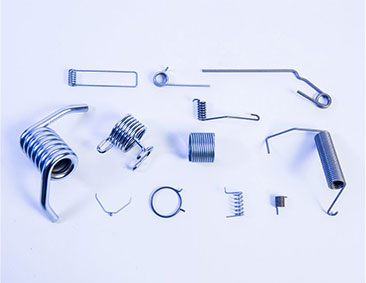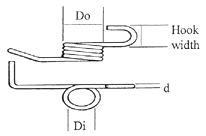
Torsion Spring Manufacturers
As expert torsion spring manufacturers, we know this type of spring is ideal where there is a requirement for angular movement with the legs of the spring attached to other components. When those components rotate around the centre of the spring, the spring tries to push them back to their original position. Torsion springs are used for hinges, counterbalances and lever return applications. They are commonly found in car door handles as they help the handle return to the original position via their abilty to exert a rotary force (torque).
Get In TouchDouble Torsion Springs
Double Torsion Springs are two single torsion springs connected together. They usually consist of one right hand coiled and one left hand coiled bodies both working in parallel with each other, doubling the effective torque available from a single torsion spring of the same size. Designs can be diverse, with centre sections and legs manufactured to any shape with the coiled bodies pitched open or closed. Double torsion springs usually work over a shaft running through the coiled bodies with either the connecting centre section or legs securely fixed. As with single torsion springs, double torsion springs should not be designed for use by winding backwards.
Designing Torsion Springs by CNC or Traditional Methods
We have continued to invest in modern CNC coiling equipment and in the training of our staff to enable the production of complex torsion spring designs and leg shapes by CNC or traditional methods. We use the latest spring design programmes to assist in solving particular torsion spring design issues and can produce a range of samples for design verification and testing.
Torsion Springs Made Sustainably
At Airedale Springs, sustainability is our top priority, and we’ve taken steps to reduce our energy consumption by 20% over the last two years, and transition to renewable sources. Our site is powered by 438 solar panels, which supply over 80% of our energy needs, and we use 100% recycled metal in our spring manufacturing.
We have even won awards for our commitment to sustainability. Learn more about sustainability at Airedale Springs.

It’s helpful to know where a spring is designed to fit and what the sizes of the hole and shaft are.
Please also let us know of any other important dimensions.

Frequently Asked Torsion Spring Questions
What are torsion springs used for?
Torsion springs are ideal for applications that require angular movement with the legs of the spring attached to other components. When those components rotate around the centre of the spring, the spring tries to push them back to their original position. Torsion springs are commonly found in hinges, counterbalances, lever return applications, and car door handles, where they help the handle return to its original position by exerting a rotary force (torque).
The agricultural and construction sectors benefit from this spring design, especially when the correct treatments and finishes are applied to enhance protection against the containments and the weather. Large torsion springs are used in tractors, ploughs and fertiliser sprayers. They are also essential for most heavy plant machinery used in construction, such as excavators and tippers.
The marine and automotive sectors will use chrome silicone torsion springs for an increasingly smooth movement between the coils without losing the required torsional resistance.
The medical sector relies on a constantly growing collection of essential medical equipment to help people, and most of these tools and machines need high-quality springs to ensure their reliable function. Small torsion springs are often used for their required capabilities within small areas such as dental equipment or prosthetics. Larger torsion springs made from carbon steel are also used in more obvious applications such as hospital beds and gurneys.
What are double torsion springs used for?
Double torsion springs are used in applications that necessitate torque to be applied in two directions, such as hinges, counterbalances, and levers where a mechanism must return to its original position after displacement.
In contrast to single torsion springs, which exert torque in only one direction, double torsion springs can apply torque in two opposing directions. Because of their dual-coil configuration, double torsion springs are more complex in design, while their single-coil counterparts are simpler.
Furthermore, double torsion springs often have the capacity to handle more load than single torsion springs, which can result in a potentially longer lifespan in applications with substantial torque demands.
While both types of springs find uses across various applications, double torsion springs are especially suitable for situations requiring opposing forces, whereas single torsion springs are commonly employed where a force in a singular direction suffices.
What is Airedale Springs' expertise in torsion spring manufacturing?
Airedale Springs has been manufacturing springs for more than 75 years and providing design assistance to many clients. We specialise in the manufacturing of torsion springs, other wire springs, and wire forms, transforming innovative ideas into fully functioning products for various sectors. Airedale Springs has worked with high-profile manufacturers and inventors, such as the Brompton Bicycle team. Our award-winning spring manufacturing process ensures cost-effective, high-quality, and functionally flawless products.
Can Airedale Springs design custom torsion springs?
Yes, Airedale Springs can design custom torsion springs for your specific needs.
When designing torsion springs, the most important starting point is the amount of torque required. Once established, our designers will then make a determination on the appropriate proportions, such as wire size and diameter, as well as the number of coils and whether the torsion spring should be ‘right-handed’ or ‘left-handed’. Airedale have also developed methods to design torsion springs that do not suffer from significant tangling problems.
Torsion springs are ideal where there is a requirement for angular movement with the legs of the spring attached to other components. When those components rotate around the centre of the spring, the spring tries to push them back to their original position. Torsion springs are used for hinges, counterbalances and lever return applications.
A little expert advice in the early stages of your spring design can help improve your product and avoid costly modifications or redesigns later.
Our team will assist and guide you from the initial concept to the end product, ensuring that your spring is tailored to be cost-effective, high-quality, and functionally flawless. You can find out more about our bespoke solutions on our custom springs page.
WHAT ARE TORSION SPRINGS?
Torsion springs are helical, or spiral springs optimised to maintain an impressive rotational pressure between attached surfaces. Unlike the more well-known compression springs, which work linear, torsion springs work rotationally.
They are manufactured as coiled wire with two extended ends that will be attached to the desired application. As the spring is manipulated, the two ends are rotated, which applies a bending stress and a resistance; this built energy is stored in the spring until the exploited force is removed and the spring returns to its original resting position.
Torsion springs generally have a much closer wound coil than other spring designs like compression springs. Additionally, some torsion designs will implement a slight pitch to reduce the friction between the adjacent coils and preserve their physical integrity longer.


